Minimising Stress for Patients in the Veterinary Hospital: Why It Is Important and What Can Be Done about It
Abstract
:1. Introduction
2. The Relationship between Fear and Anxiety
3. Recognising Stress in Animals
3.1. Signs of Fear in Dogs
3.2. Signs of Fear in Cats
4. Preparation for Visits to the Hospital
5. Greeting Behaviour of the Veterinary Staff
6. Handling and Restraint
7. Medications for Behavioural Management
8. Creating a Pet-Friendly Environment: Hospital Design
8.1. The Waiting Room
8.2. The Exam Room
8.3. Cages and Housing
8.4. The Acoustic and Olfactory Environment
8.5. Colour and Lighting
9. Creating a Pet-Friendly Environment: Other Calming Agents and Techniques
9.1. Pheromonotherapy
9.2. Pressure Touch
Touch has been reported to have calming effects in a variety of animals and people including children with autistic disorders, premature babies (swaddled), normal babies and adults (Grandin, 1992, 2007). An overview of Touch triggers a raft of changes in the nervous system, from local chemical responses to the release of endogenous opioids. The effect of touch in stimulating the skin has a massive, indirect effect on the rest of the body (Lindley, 2009), including the release of oxytocin and prolactin (amongst other hormones) which are important for bonding and nurturing (Case, 2005; Odendaal and Meintjes, 2003). Physical contact, such as stroking, has also been found to induce physiological relaxation of the heart in pet dogs (McGreevy, Righetti and Thomson, 2005).
9.3. Aromatherapy and Other Olfactory Stimuli
9.4. Other Complimentary Therapies
10. Conclusions
Acknowledgments
Conflicts of Interest
References
- Hewson, C. Stress in small animal patients: Why it matters and what to do about it. Ir. Vet. J. 2008, 61, 249–254. [Google Scholar]
- Hewson, C. Why are (n’t) you using pheromones in your hospital ward? There’s more to reducing patient stress. Vet. Ir. J. 2012, 2, 84–90. [Google Scholar]
- Yin, S. Low Stress Handling, Restraint and Behavior Modification of Dogs and Cats: Techniques for Patients Who Love Their Visits; CattleDog Publishing: Davis, CA, USA, 2009. [Google Scholar]
- Overall, K.L. Fear Factor: Is Routine Veterinary Care Contributing to Lifelong Patient Anxiety? 2013. Available online: http://veterinarynews.dvm360.com/fear-factor-routine-veterinary-care-contributing-lifelong-patient-anxiety (accessed on 21 December 2016).
- Overall, K.L. Facing Fear Head on: Tips for Veterinarians to Create a More Behavior-Centered Practice. 2013. Available online: http://veterinarynews.dvm360.com/facing-fear-head-tips-veterinarians-create-more-behavior-centered-practice (accessed on 21 December 2016).
- Lloyd, J. Behaviour and welfare—Minimising stress for patients in the veterinary hospital. In Proceedings of the Australian Veterinary Association North Queensland Branch Conference, Townsville, Australia, 22–24 August 2014; pp. 62–64. [Google Scholar]
- Tynes, V.V. The Physiologic Effects of Fear. 2014. Available online: http://veterinarymedicine.dvm360.com/physiologic-effects-fear (accessed on 21 December 2016).
- AVSAB. AVSAB Position Statement on Positive Veterinary Care. American Veterinary Society of Animal Behavior. 2016. Available online: https://avsab.org/wp-content/uploads/2017/01/Positive-Veterinary-Care-Position-Statement-download.pdf (accessed on 21 February 2017).
- Harvey, A. A cat friendly clinic—Why do you need it & how do you do it? In Proceedings of the Feline Medicine Seminar, Proc. No. 437, Townsville, QLD, Australia, 12–13 November 2016; Centre for Veterinary Education: Camperdown, Australia, 2016; pp. 1–20. [Google Scholar]
- Moberg, G.P.; Mench, J.A. The Biology of Animal Stress: Basic Principles and Implications for Animal Welfare; Cabi Publishing: Oxon, UK, 2000. [Google Scholar]
- Döring, D.; Roscher, A.; Scheipl, F.; Küchenhoff, H.; Erhard, M.H. Fear-related behaviour of dogs in veterinary practice. Vet. J. 2009, 182, 38–43. [Google Scholar] [CrossRef] [PubMed]
- Volk, J.O.; Felsted, K.E.; Thomas, J.G.; Siren, C.W. Executive summary of the Bayer veterinary care usage study. J. Am. Vet. Med. Assoc. 2011, 238, 1275–1282. [Google Scholar] [CrossRef] [PubMed]
- Overall, K.L. Karen Overall on the Effects of Fear on Veterinary Patients. 2014. Available online: http://veterinarynews.dvm360.com/facing-fear-head-tips-veterinarians-create-more-behavior-centered-practice (accessed on 21 December 2016).
- Dawson, L.C.; Dewey, C.E.; Stone, E.A.; Guerin, M.T.; Niel, L. A survey of animal welfare experts and practicing veterinarians to identify and explore key factors thought to influence canine and feline welfare in relation to veterinary care. Anim. Welf. 2016, 25, 125–134. [Google Scholar] [CrossRef]
- Godbout, M.; Frank, D. Persistence of puppy behaviors and signs of anxiety during adulthood. J. Vet. Behav. 2011, 6, 92. [Google Scholar] [CrossRef]
- Rodan, I.; Sundahl, E.; Carney, H.; Gagnon, A.C.; Heath, S.; Landsberg, G.; Seksel, K.; Yin, S. AAFP and ISFM feline-friendly handling guidelines. J. Feline Med. Surg. 2011, 13, 364–375. [Google Scholar] [CrossRef] [PubMed]
- Hammerle, M.; Horst, C.; Levine, E.; Overall, K.; Radosta, L.; Rafter-Ritchie, M.; Yin, S. AAHA canine and feline behavior management guidelines. J. Am. Anim. Hosp. Assoc. 2015, 51, 205–221. [Google Scholar] [CrossRef] [PubMed]
- Landsberg, G.; Hunthausen, W.; Ackerman, L. Behavior Problems of the Dog and Cat, 3rd ed.; Saunders Elsevier: Edinburgh, Scotland, 2013. [Google Scholar]
- Dybdall, K.; Strasser, R.; Katz, T. Behavioral differences between owner surrender and stray domestic cats after entering an animal shelter. Appl. Anim. Behav. Sci. 2007, 104, 85–94. [Google Scholar] [CrossRef]
- Gregory, N.G. Physiology and Behaviour of Animal Suffering; Blackwell: Oxford, UK, 2004. [Google Scholar]
- Jeyaretnam, J.; Jones, H.; Phillips, M. Disease and injury among veterinarians. Aust. Vet. J. 2000, 78, 625–629. [Google Scholar] [PubMed]
- Steimer, T. The biology of fear-and anxiety-related behaviors. Dialogues Clin. Neurosci. 2002, 4, 231–249. [Google Scholar] [PubMed]
- Overall, K.L. Manual of Clinical Behavioral Medicine for Dogs and Cats; Elsevier Mosby: St. Louis, MO, USA, 2013. [Google Scholar]
- Overall, K.L. Do Dogs Appease Each Other—Or Us? Veterinary Research Focuses on Watching and Labeling Canine Interactions. 2014. Available online: http://veterinarynews.dvm360.com/do-dogs-appease-each-other-or-us-veterinary-research-focuses-watching-and-labeling-canine-interactio (accessed on 21 December 2016).
- Kendall, K.; Ley, J. Cat ownership in Australia: Barriers to ownership and behavior. J. Vet. Behav. Clin. Appl. Res. 2006, 1, 5–16. [Google Scholar] [CrossRef]
- Yin, S. Crate Training Handout. Available online: http://info.drsophiayin.com/crate-training-handout (accessed on 3 April 2017).
- Kirchhofer, K.C.; Zimmermann, F.; Kaminski, J.; Tomasello, M. Dogs (Canis familiaris), but not chimpanzees (Pan troglodytes), understand imperative pointing. PLoS ONE 2012, 7. [Google Scholar] [CrossRef] [PubMed]
- Pilley, J.W.; Reid, A.K. Border collie comprehends object names as verbal referents. Behav. Process. 2011, 86, 184–195. [Google Scholar] [CrossRef] [PubMed]
- Mariti, C.; Gazzano, A.; Moore, J.L.; Baragli, P.; Chelli, L.; Sighieri, C. Perception of dogs’ stress by their owners. J. Vet. Behav. Clin. Appl. Res. 2012, 7, 213–219. [Google Scholar] [CrossRef]
- Yin, S. Low Stress Handling of Dogs and Cats [DVD]; CattleDog Publishing: Davis, CA, USA, 2012. [Google Scholar]
- Landsberg, G. Behavior Medicine: Easing Patient Fear. 2009. Available online: http://veterinarynews.dvm360.com/behavior-medicine-easing-patient-fear (accessed on 21 December 2016).
- Kuhne, F.; Hößler, J.C.; Struwe, R. Behavioral and cardiac responses by dogs to physical human–dog contact. J. Vet. Behav. 2014, 9, 93–97. [Google Scholar] [CrossRef]
- Soemichsen, S.; Chamove, A.S. Responses of cats to petting by humans. Anthrozoös 2015, 15, 258–265. [Google Scholar] [CrossRef]
- Overall, K.L. Your Complete Guide to Reducing Fear in Veterinary Patients. 2014. Available online: http://veterinarynews.dvm360.com/your-complete-guide-reducing-fear-veterinary-patients (accessed on 21 December 2016).
- Frank, D.; Gauthier, A.; Bergeron, R. Placebo-controlled double-blind clomipramine trial for the treatment of anxiety or fear in beagles during ground transport. Can. Vet. J. 2006, 47, 1102–1108. [Google Scholar] [PubMed]
- Overall, K.L. Clinical Behavioral Medicine for Small Animals; Mosby-Year Book, Inc.: St. Louis, MO, USA, 1997. [Google Scholar]
- Thompson, S.B. Pharmacologic treatment of phobias. In Psychopharmacology of Animal Behavior Disorders; Dodman, N.H., Shuster, L., Eds.; Blackwell Science: Malden, MA, USA, 1998; pp. 141–182. [Google Scholar]
- Bergeron, R.; Shannon, L.S.; Émond, J.-P.; Mercier, F.; Cook, N.J.; Schaefer, A.L. Physiology and behavior of dogs during air transport. Can. J. Vet. Res. 2002, 66, 211–216. [Google Scholar] [PubMed]
- Overall, K.L. Your Guide to Understanding How Behavior Medications Work. 2007. Available online: http://veterinarynews.dvm360.com/your-guide-understanding-how-behavior-medications-work?id=&pageID=1&sk=&date= (accessed on 21 December 2016).
- Lainesse, C.; Frank, D.; Beaudry, F.; Doucet, M. Comparative oxidative metabolic profiles of clomipramine in cats, rats and dogs: Preliminary results from an in vitro study. J. Vet. Pharmocol. Therap. 2007, 30, 387–393. [Google Scholar] [CrossRef] [PubMed]
- Gwaltney-Brant, S.M.; Albretsen, J.C.; Khan, S.A. 5-Hydroxytryptophan toxicoses in dogs: 21 Cases. J. Am. Vet. Med. Assoc. 2002, 216, 1937–1940. [Google Scholar] [CrossRef]
- Crowell-Davies, S.L.; Landsberg, G.M. Pharmacology and pheromone therapy. In BSAVA Manual of Canine and Feline Behavioural Medicine, 2nd ed.; Horwitz, D.F., Mills, D.D., Eds.; BSAVA: Gloucester, UK, 2012; pp. 245–258. [Google Scholar]
- Horwitz, D.F.; Mills, S.M. BSAVA Manual of Canine and Feline Behavioural Medicine, 2nd ed.; BSAVA: Gloucester, UK, 2012. [Google Scholar]
- Overall, K.L. Medications for Fearful Dogs and Cats. 2014. Available online: http://veterinarynews.dvm360.com/medications-fearful-dogs-and-cats (accessed on 21 December 2016).
- Schwartz, S. Psychoactive Herbs in Veterinary Behavior Medicine; Blackwell: Ames, IA, USA, 2005. [Google Scholar]
- McCobb, E.C.; Patronek, G.J.; Marder, A.; Dinnage, J.D.; Stone, M.S. Assessment of stress levels among cats in four animal shelters. J. Am. Vet. Med. Assoc. 2005, 226, 548–555. [Google Scholar] [CrossRef] [PubMed]
- Lloyd, J.K.F. Concepts in animal welfare: Environmental enrichment. N. Z. Vet. Nurse J. 2008, 48, 22–27. [Google Scholar]
- Hernander, L. Factors Influencing Dogs’ Stress Level in the Waiting Room at a Veterinary Clinic. Student Report. Swedish University of Agricultural Sciences, Department of Animal Environment and Health, Ethology and Animal Welfare Programme. 2008. Available online: http://ex-epsilon.slu.se/3006/1/huvudversion_klar_lollo.pdf (accessed on 21 December 2016).
- Lloyd, J.K.F.; Roe, E. Integrating the Tellington TTouch Method in Guide Dog Training. In Proceedings of the 14th International Mobility Conference, Palmerston North, New Zealand, 13–16 February 2012; pp. 127–130. [Google Scholar]
- Neitz, J.; Geist, T.; Jacobs, G.H. Color vision in the dog. Vis. Neurosci. 1989, 3, 119–125. [Google Scholar] [CrossRef] [PubMed]
- Kry, K.; Casey, R. The effect of hiding enrichment on stress levels and behaviour of domestic cats (Felis sylvestris catus) in a shelter setting and the implications for adoption potential. Anim. Welf. 2007, 16, 375–383. [Google Scholar]
- Kogan, L.R.; Schoenfeld-Tacher, R.; Simon, A.A. Behavioral effect of auditory stimulation on kenneled dogs. J. Vet. Behav. 2012, 7, 268–275. [Google Scholar] [CrossRef]
- Wells, D.L.; Graham, L.; Hepper, P.G. The influence of auditory stimulation on the behavior of dogs housed in a rescue shelter. Anim. Welf. 2002, 11, 385–393. [Google Scholar]
- Brayley, C.; Montrose, V.T. The effects of audiobooks on the behaviour of dogs at a rehoming kennels. Appl. Anim. Behav. Sci. 2016, 174, 111–115. [Google Scholar] [CrossRef]
- McConnell, P. New Research on Dogs and Music. 2013. Available online: https://www.patriciamcconnell.com/theotherendoftheleash/new-research-on-dogs-and-music (accessed on 21 December 2016).
- McConnell, P. Acoustic structure and receiver response in domestic dogs, Canis familiaris. Anim. Behav. 1990, 39, 897–904. [Google Scholar] [CrossRef]
- Snowden, C.T.; Teie, D.; Savage, M. Cats prefer species-appropriate music. Appl. Anim. Behav. Sci. 2015, 166, 106–111. [Google Scholar] [CrossRef]
- Moser, S.A. Combatting Noise and Odor. 2004. Available online: http://veterinaryhospitaldesign.dvm360.com/combatting-noise-and-odor (accessed on 21 December 2016).
- Lewis, H. Fear-Free: What You See Is Not What the Cat or Dog Gets. 2015. Available online: http://veterinaryhospitaldesign.dvm360.com/fear-free-what-you-see-not-what-cat-or-dog-gets (accessed on 21 December 2016).
- Denenberg, S.; Landsberg, G.M. Effects of dog-appeasing pheromones on anxiety and fear in puppies during training and on long-term socialization. J. Am. Vet. Med. Assoc. 2008, 233, 1874–1882. [Google Scholar] [CrossRef] [PubMed]
- Frank, D.; Beauchamp, G.; Palestrini, C. Systematic review of the use of pheromones for treatment of undesirable behavior in cats and dogs. J. Am. Vet. Med. Assoc. 2010, 236, 1308–1316. [Google Scholar] [CrossRef] [PubMed]
- Lloyd, J.; Roe, E. Using TTouch to reduce stress and enhance learning when training guide dogs. Int. J. Orientat. Mobil. 2014, 6, 8–20. [Google Scholar]
- Graham, L.; Wells, D.L.; Hepper, P.G. The influence of olfactory stimulation on the behaviour of dogs housed in a rescue shelter. Appl. Anim. Behav. Sci. 2005, 91, 143–153. [Google Scholar] [CrossRef]
- Addie, D.D.; Boucraut-Baralon, C.; Egberink, H.; Frymus, T.; Gruffyd-Jones, T.; Hartmann, K.; Horzinek, M.C.; Hosie, M.J.; Lloret, A.; Lutz, H.; et al. Disinfectant choices in veterinary practices, shelters and households: ABCD guidelines on safe and effective disinfection for feline environments. J. Feline Med. Surg. 2015, 17, 594–605. [Google Scholar] [CrossRef] [PubMed]
- Genovese, G.G.; McLean, M.K.; Khan, S.A. Adverse reactions from essential oil-containing natural flea products exempted from Environmental Protection Agency regulations in dogs and cats. Vet. Emerg. Crit. Care 2012, 22, 470–475. [Google Scholar] [CrossRef] [PubMed]
- Ellis, S.L.H.; Wells, D.L. The influence of olfactory stimulation on the behaviour of cats housed in a rescue shelter. Appl. Anim. Behav. Sci. 2010, 123, 56–62. [Google Scholar] [CrossRef]
- Lindley, S. Complimentary therapies. In BSAVA Manual of Canine and Feline Behavioural Medicine, 2nd ed.; Horwitz, D.F., Mills, D.D., Eds.; BSAVA: Gloucester, UK, 2012; pp. 259–269. [Google Scholar]
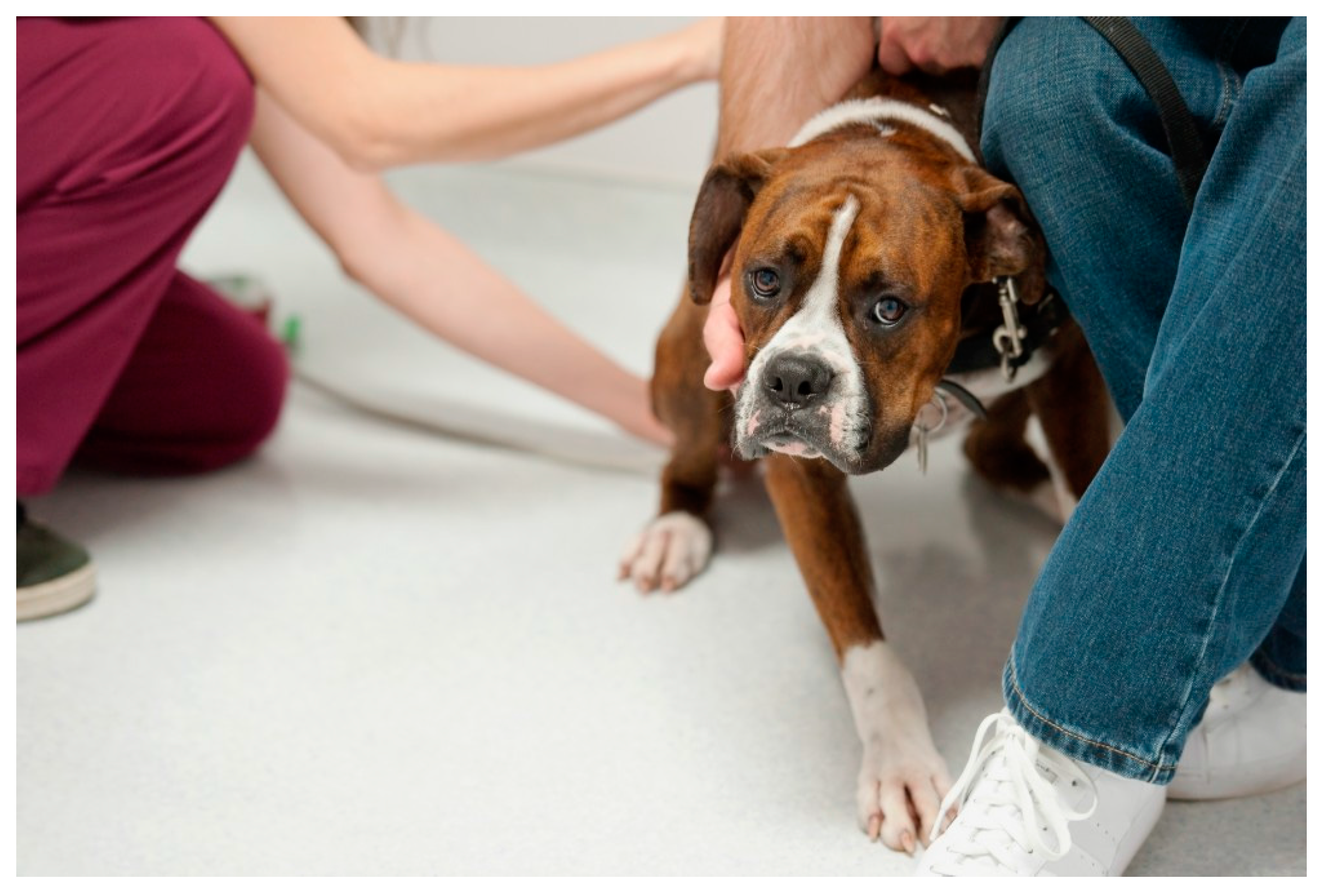

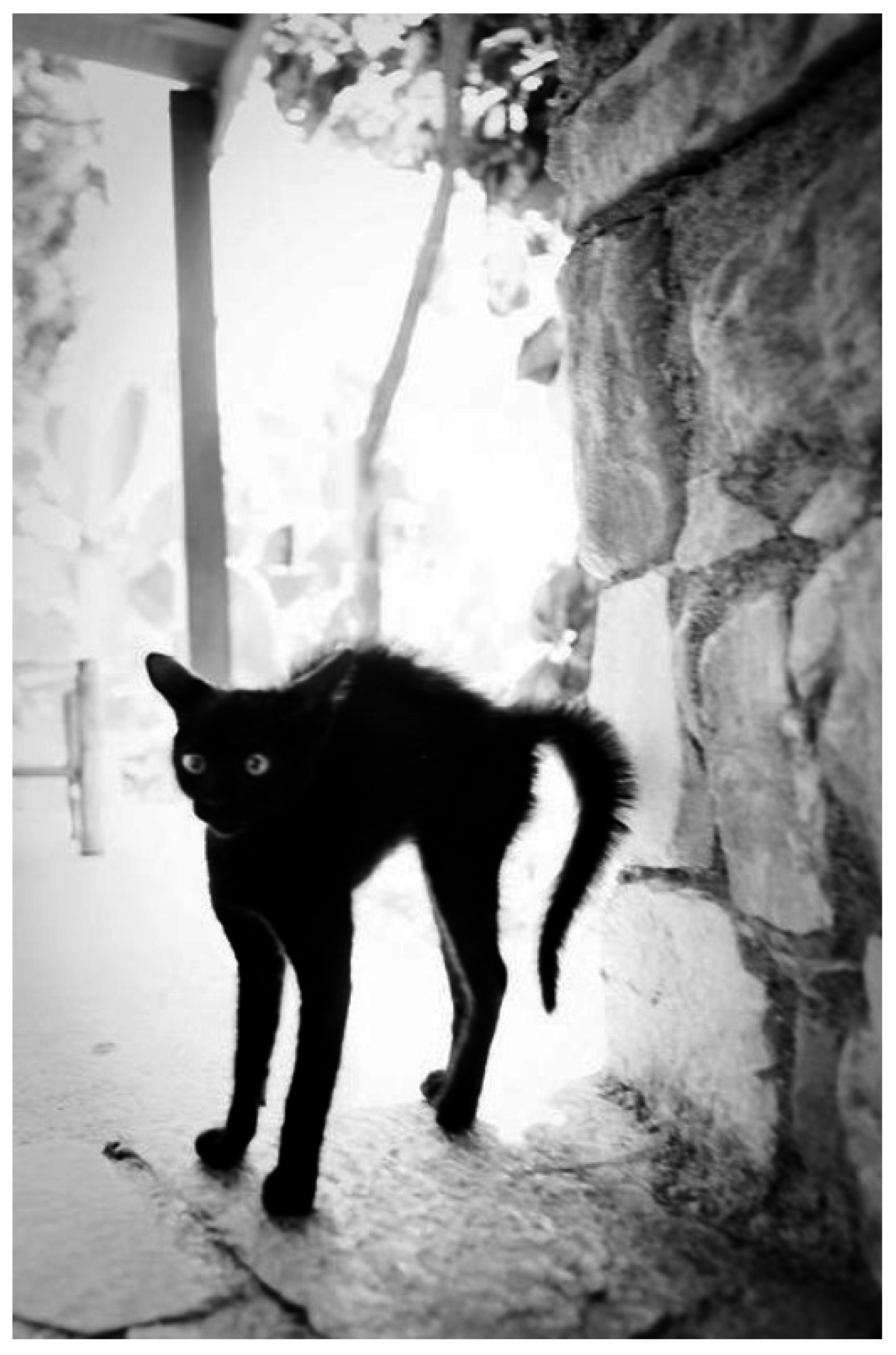
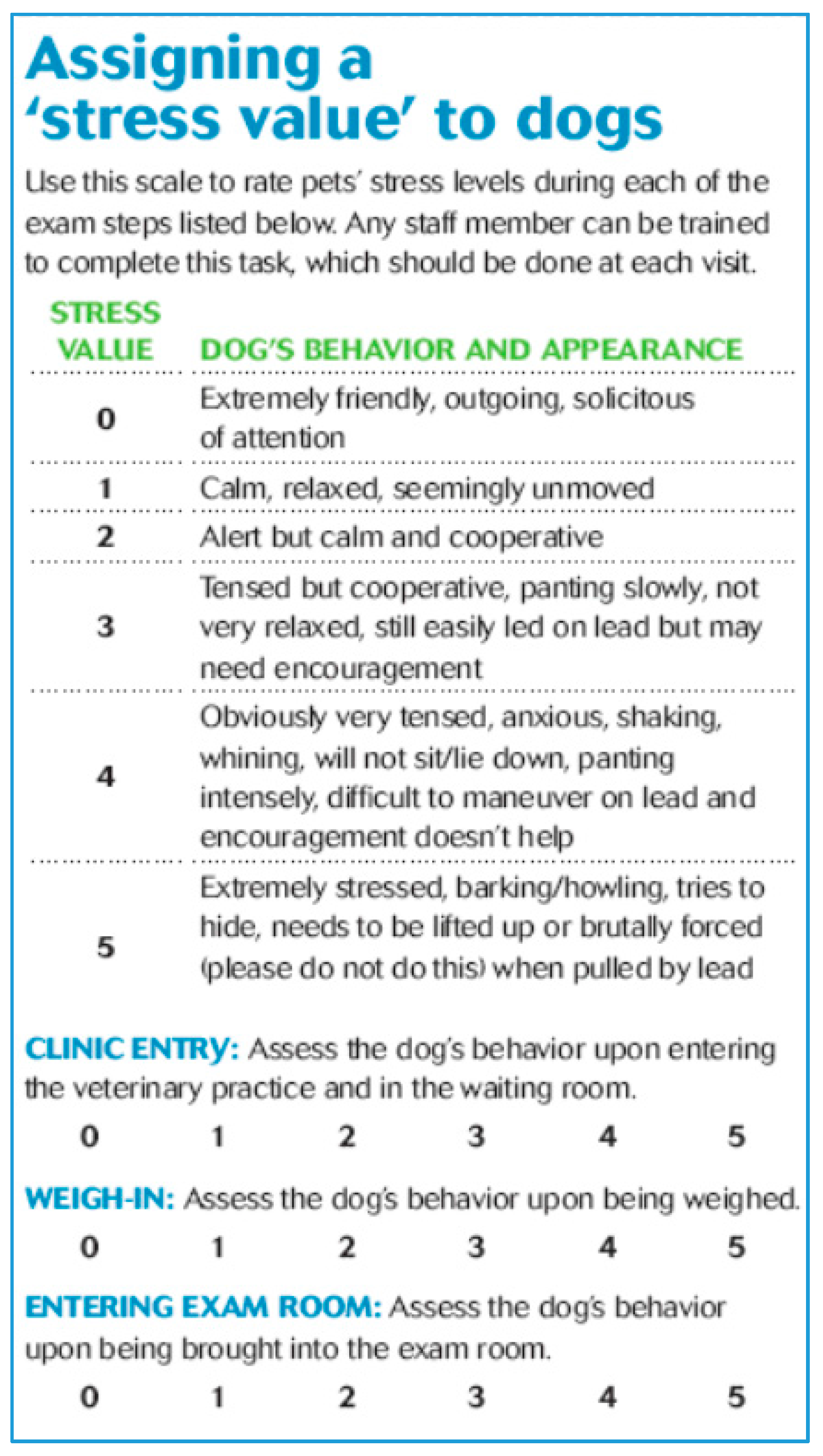
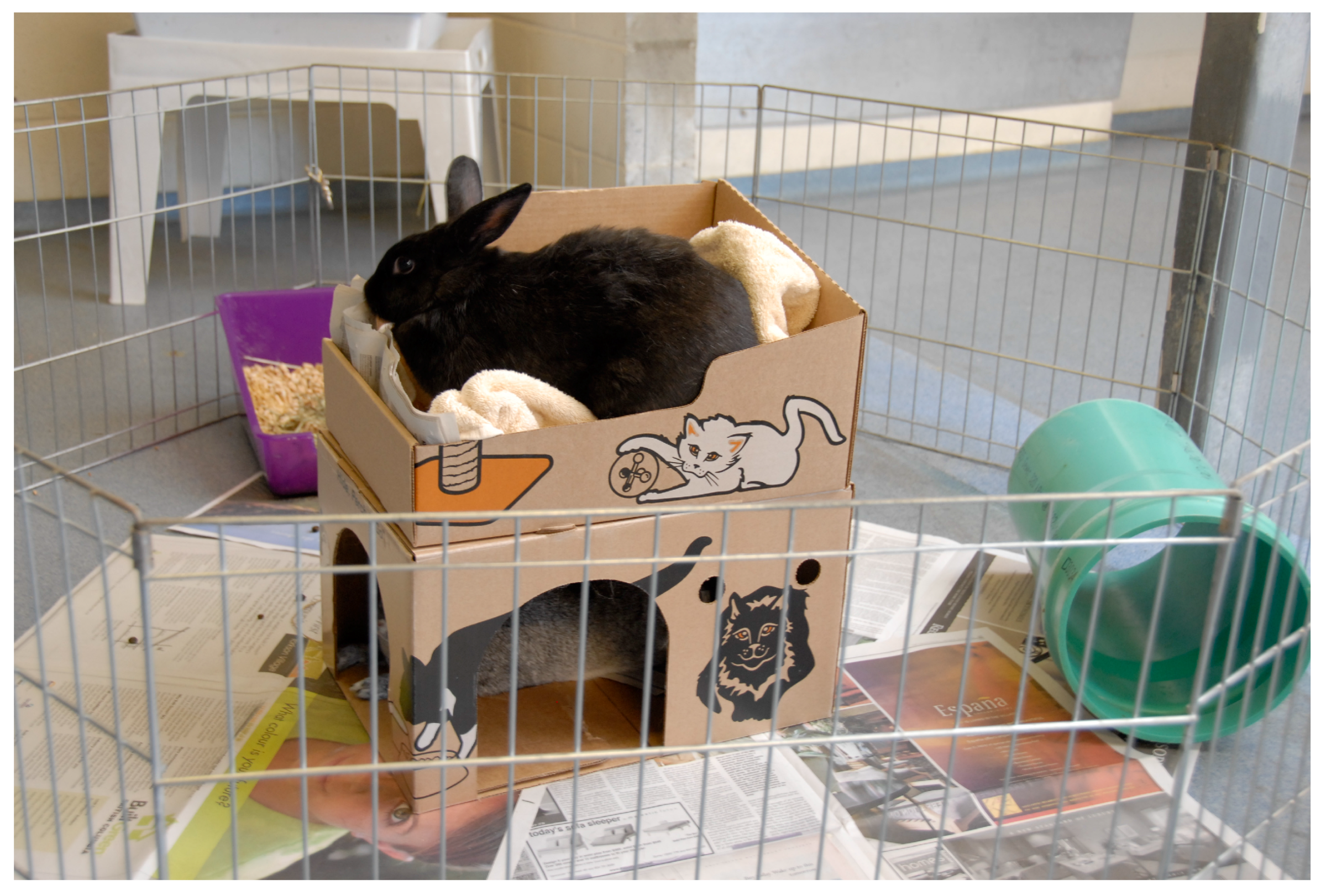

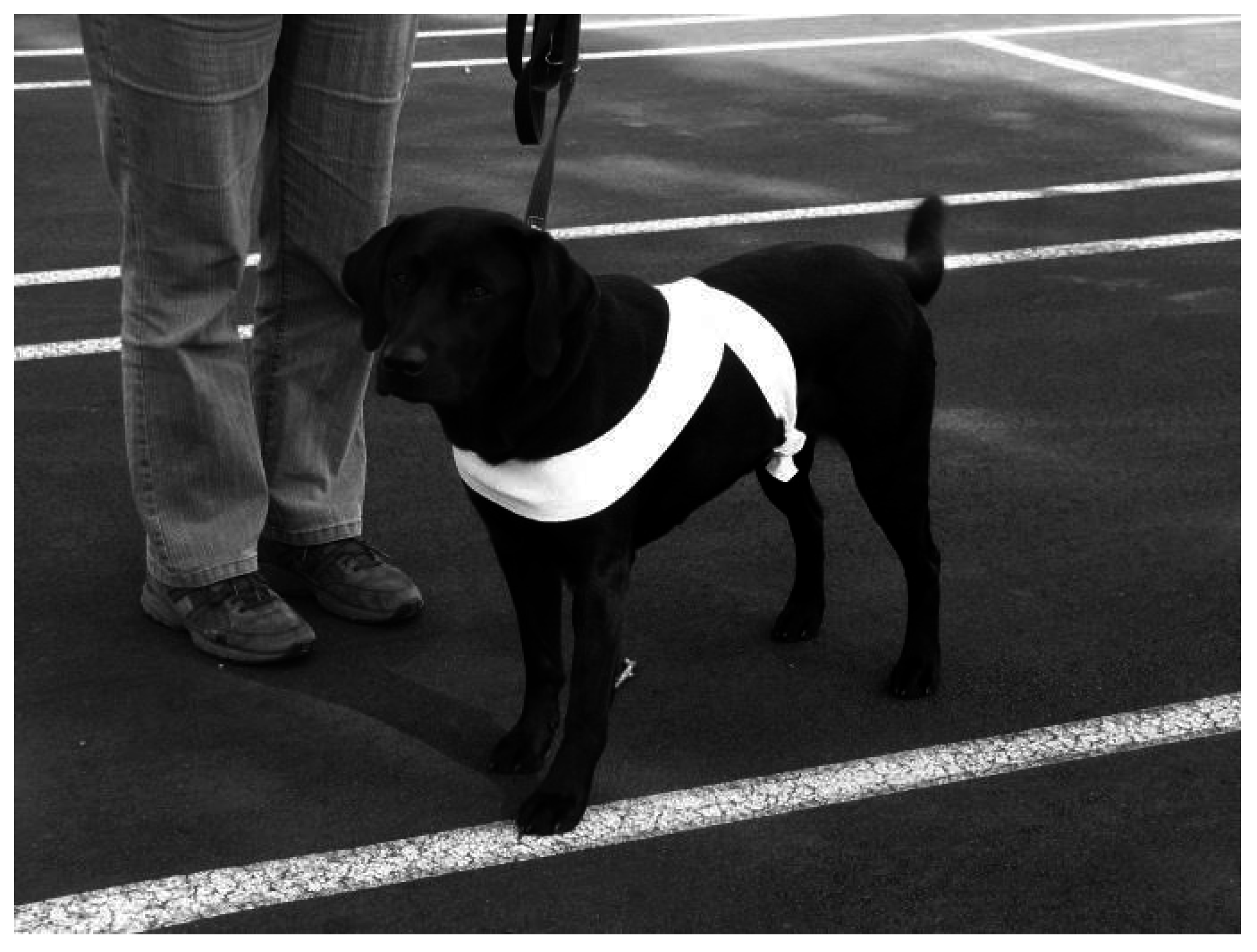
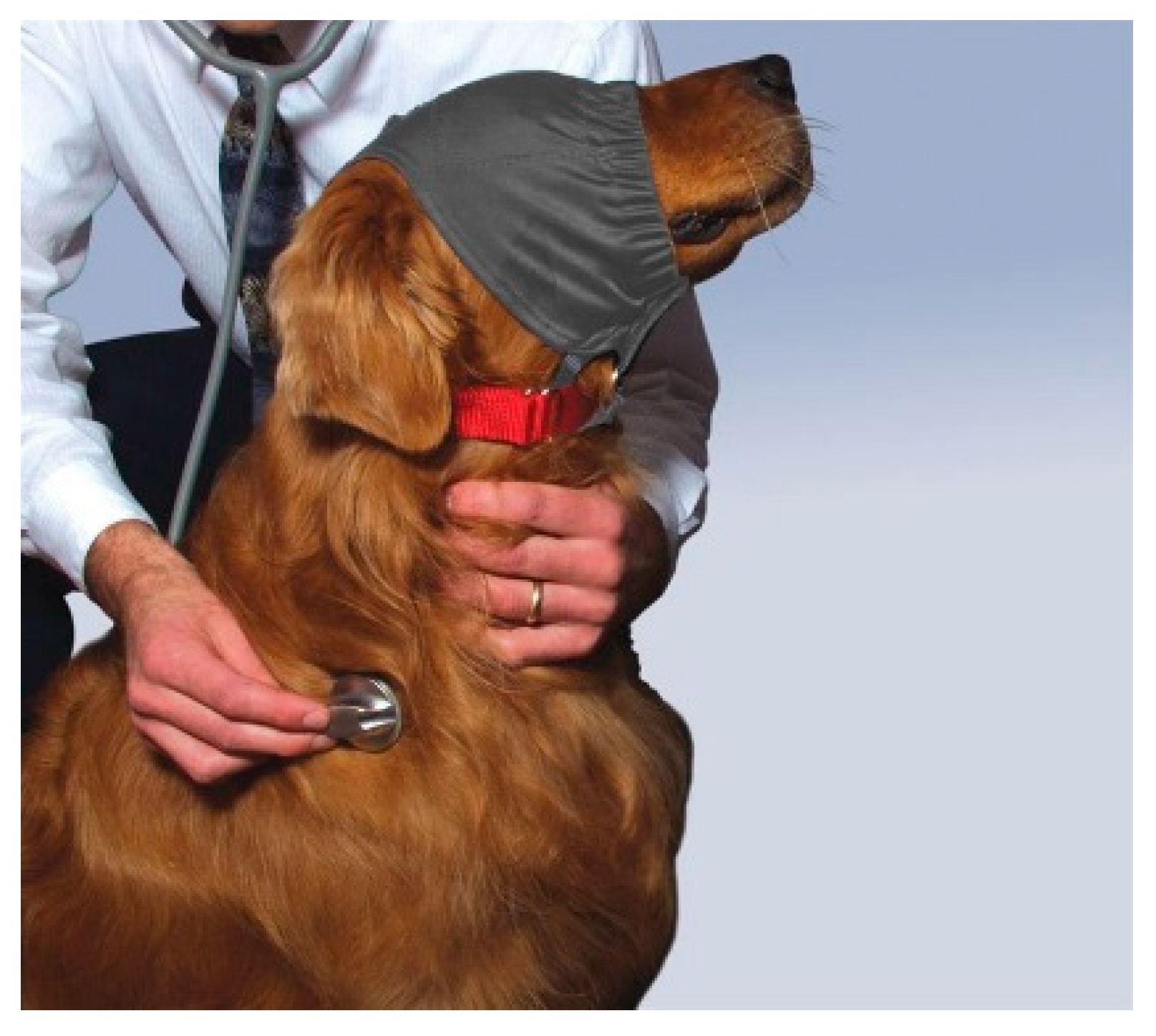
© 2017 by the author. Licensee MDPI, Basel, Switzerland. This article is an open access article distributed under the terms and conditions of the Creative Commons Attribution (CC BY) license (http://creativecommons.org/licenses/by/4.0/).
Share and Cite
Lloyd, J.K.F. Minimising Stress for Patients in the Veterinary Hospital: Why It Is Important and What Can Be Done about It. Vet. Sci. 2017, 4, 22. https://doi.org/10.3390/vetsci4020022
Lloyd JKF. Minimising Stress for Patients in the Veterinary Hospital: Why It Is Important and What Can Be Done about It. Veterinary Sciences. 2017; 4(2):22. https://doi.org/10.3390/vetsci4020022
Chicago/Turabian StyleLloyd, Janice K. F. 2017. "Minimising Stress for Patients in the Veterinary Hospital: Why It Is Important and What Can Be Done about It" Veterinary Sciences 4, no. 2: 22. https://doi.org/10.3390/vetsci4020022





